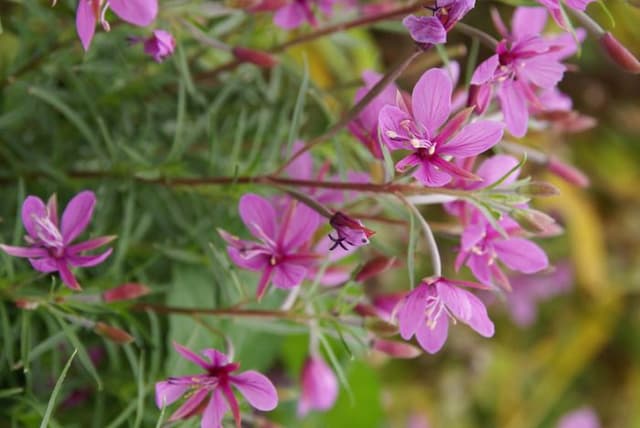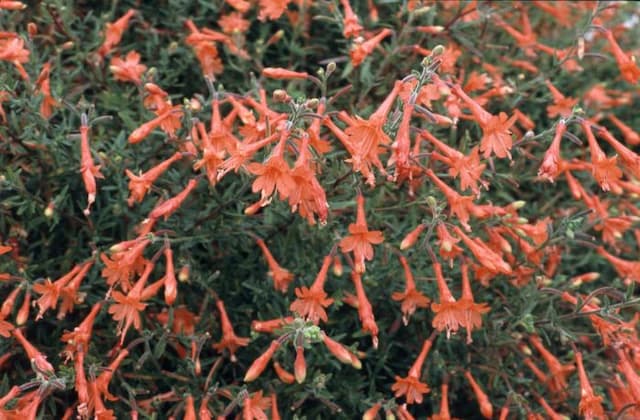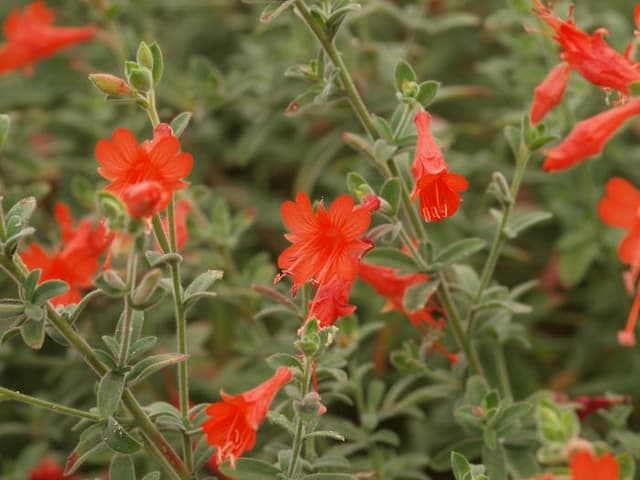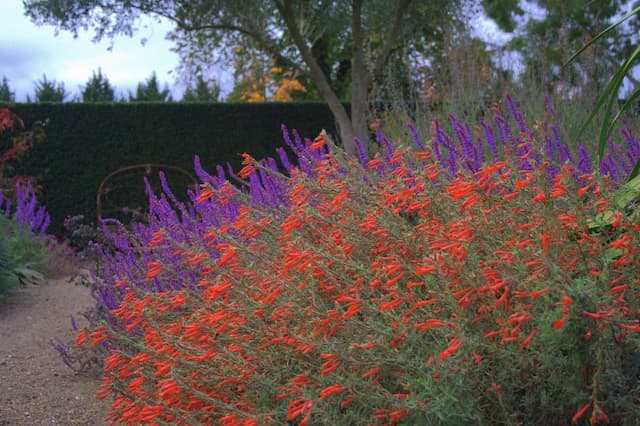Fuchsia Fuchsia 'Tom West' Meillez (v)
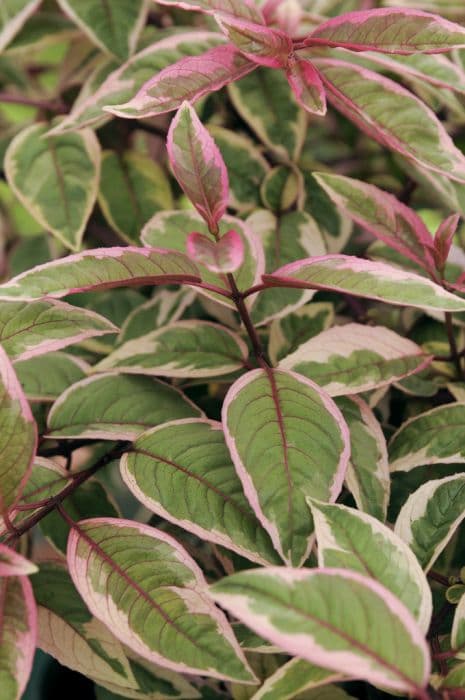
ABOUT
Fuchsia 'Tom West' is a striking ornamental plant that is especially noted for its unique and attractive foliage and vibrant flowers. The leaves of this variety have a distinct variegation, with creamy white to light green edges that blend into a deep green center. Each leaf is also touched with a subtle pink or purplish hue, adding further interest to the foliage. These leaves are somewhat small, with a delicate oval shape that tapers to a point. The flowers of Tom West Fuchsia are equally eye-catching, suspended from the stems in a graceful, dangling manner that is characteristic of fuchsias. Each bloom consists of a two-toned combination of a deep purple to magenta outer layer, which peels back to reveal a contrasting inner skirt of bright pink to reddish purple petals. These tubular flowers often attract hummingbirds and other pollinators, making the plant not only beautiful but beneficial for the garden ecosystem. Adding to its decorative charm, the stems of the Tom West Fuchsia are also distinctive, often showing off a reddish or purplish coloring that harmonizes with the foliage and flowers. The overall impression of the plant is one of a lively and colorful specimen, making it a popular choice for gardeners who wish to add vibrancy to their plantings.
About this plant
 Names
NamesFamily
Onagraceae
Synonyms
Tom West Fuchsia, Variegated Fuchsia
Common names
Fuchsia 'Tom West' Meillez (v).
 Toxicity
ToxicityTo humans
Fuchsia, including the 'Tom West' variety, is not considered toxic to humans. There are no significant symptoms associated with ingesting this plant, as it's generally regarded as non-poisonous.
To pets
Fuchsia plants, including the 'Tom West' variety, are generally considered safe and non-toxic to pets such as dogs and cats. Ingesting parts of this plant should not cause any significant symptoms of poisoning in pets.
 Characteristics
CharacteristicsLife cycle
Perennials
Foliage type
Deciduous
Color of leaves
Variegated
Flower color
Mixed
Height
1-2 feet (30-60 cm)
Spread
1-2 feet (30-60 cm)
Plant type
Shrub
Hardiness zones
9
Native area
Central America
Benefits
 General Benefits
General Benefits- Attractive Foliage: Fuchsia 'Tom West' is known for its variegated leaves with green, cream, and purple hues, adding color interest to garden spaces.
- Ornamental Flowers: The fuchsia bears distinct, pendulous flowers that are typically pink and purple, which can enhance the visual appeal of any garden or container.
- Habitat for Wildlife: Its flowers produce nectar that attracts pollinators like bees, butterflies, and hummingbirds, providing them with a food source.
- Shade Tolerant: This variety of fuchsia can thrive in partial shade, making it ideal for gardeners with less sunny spaces.
- Versatility: Fuchsia 'Tom West' can be used in a variety of garden settings, such as hanging baskets, containers, or as a border plant.
- Long Blooming Season: It typically has a long flowering season, often blooming from summer well into the fall, offering extended visual interest in the garden.
 Medical Properties
Medical PropertiesThis plant is not used for medical purposes.
 Air-purifying Qualities
Air-purifying QualitiesThis plant is not specifically known for air purifying qualities.
 Other Uses
Other Uses- Edible Flowers: Fuchsia flowers are edible and can be used to decorate salads, desserts, or cocktails for a touch of color and a mildly tangy flavor.
- Photography Prop: Fuchsia plants, with their distinctive and vibrant flowers, can serve as striking subjects or backdrops for macro and nature photography.
- Creative Art Medium: The flowers and leaves can be used in pressed flower art, contributing their unique shapes and colors to create natural artwork.
- Educational Tool: Fuchsia plants can be used to teach principles of botany and horticulture, explaining their growth habits and requirements for thriving.
- Natural Dye: The pigments in fuchsia flowers might be used to produce a natural dye for fabrics or art projects.
- Garden Design: These plants can be used to create a 'living wall' or vertical garden, providing aesthetic appeal and spatial structure to small garden spaces.
- Jewelry Inspiration: The unique appearance of fuchsia flowers can inspire designs for earrings, pendants, and other pieces of jewelry that mimic their dangling, lantern-like shape.
- Event Decor: Cut fuchsias can be incorporated into floral arrangements or table settings for events such as weddings, adding a splash of color and elegance.
- Fauna Attraction: Fuchsia plants can be used strategically in gardens to attract hummingbirds and beneficial insects, promoting biodiversity.
- Container Gardening: These versatile plants are well-suited for containers, allowing for ornamental use on patios, balconies, and other small outdoor spaces.
Interesting Facts
 Feng Shui
Feng ShuiThe plant Fuchsia is not used in Feng Shui practice.
 Zodiac Sign Compitability
Zodiac Sign CompitabilityThe plant Fuchsia is not used in astrology practice.
 Plant Symbolism
Plant Symbolism- Elegance and Grace: The fuchsia plant, with its delicate, teardrop-shaped flowers, is often associated with sophistication and understated elegance.
- Good Taste: The striking beauty and unique flower form of the fuchsia can signify good taste and a preference for refined beauty.
- Confiding Love: In the language of flowers, fuchsia can represent confiding love, suggesting a trusting, open relationship.
- Ambiguity and Subtlety: The complex shape and two-tone colors of many fuchsia flowers embody the idea of nuance and layers of meaning.
- Warning: Some interpretations of fuchsia's symbolism include a sense of warning, due to the plant's sometimes surprising color combinations, reminding observers to proceed with caution.
 Water
WaterThe Fuchsia 'Tom West' should be watered moderately, ensuring the soil is kept moist but not soggy. During the growing season, it's typically recommended to water this plant once or twice a week, depending on the climate and the plant's environment. Aim to provide about one gallon of water each time you water an established plant, adjusting for temperature and humidity which may accelerate the need for watering. Overwintering plants should be watered less frequently, allowing the top inch of soil to dry out before watering again. Always use room temperature water to avoid shocking the plant's roots.
 Light
LightThe Fuchsia 'Tom West', commonly known as Variegated Fuchsia, thrives in bright, indirect light. It can also benefit from some morning sunlight but should be protected from harsh afternoon sun, which can scorch the leaves. The ideal spot for this fuchsia would be in an east-facing garden or near a window where it gets gentle morning light but is shielded from intense midday rays.
 Temperature
TemperatureVariegated Fuchsia prefers a mild temperature range, ideally between 55°F and 75°F. It should be protected from temperatures below 50°F, as cold weather can damage the plant. During the summer months, it is crucial to ensure that the Variegated Fuchsia is not exposed to temperatures above 80°F for prolonged periods. To maintain optimal growth, keep the plant in a location where the temperature is consistent and within the suggested range.
 Pruning
PruningPruning Variegated Fuchsia is essential to encourage a bushier growth habit and more flowers. It's best to prune in the late winter or early spring before new growth begins. Remove dead or weak growth, and shorten long branches to maintain the desired shape of the plant. Pruning can be done several times throughout the growing season to keep the plant tidy, but avoid heavy pruning in late summer or fall, which could reduce the number of blooms.
 Cleaning
CleaningAs needed
 Soil
SoilFuchsia 'Tom West' thrives in a well-draining soil mix consisting of loam, peat, and sand, or a commercial potting mix with added perlite for aeration. They prefer slightly acidic to neutral soil, with an ideal pH range of about 6.0 to 7.0 for optimal growth.
 Repotting
RepottingFuchsia 'Tom West' should be repotted annually or when it outgrows its current pot, which is typically every 1-2 years. Early spring, before the onset of the growing season, is the best time for repotting.
 Humidity & Misting
Humidity & MistingFuchsia 'Tom West' prefers a high humidity environment, with the best conditions being between 60-70% humidity. They benefit from regular misting or placement on a pebble tray with water to increase immediate surroundings' moisture levels.
 Suitable locations
Suitable locationsIndoor
Place Fuchsia 'Tom West' in bright, indirect light, keep soil moist.
Outdoor
Hang in dappled shade, protect from strong winds and frost.
Hardiness zone
10-11 USDA
 Life cycle
Life cycleFuchsia 'Tom West', commonly known as Hardy Fuchsia, begins its life cycle when a seed germinates, typically in warm and moist soil conditions. The seedling emerges, develops roots and a shoot, and as it matures, it forms distinctive foliage with creamy variegation and marbled pink and green leaves. The plant continues to grow and eventually produces its characteristic drooping flowers, usually in shades of purple and pink, which are attractive to pollinators like hummingbirds. Following pollination, the flowers develop into small, dark-colored fruits, which contain seeds for the next generation of plants. Throughout the growing season, Hardy Fuchsia requires pruning to maintain shape and encourage bushier growth. As a perennial, it will go dormant in colder climates during the winter, with the roots surviving underground to regrow the following spring.
 Propogation
PropogationPropogation time
Spring to summer
The Fuchsia 'Tom West' Meillez (v) can be propagated by taking softwood cuttings during spring or early summer when the plant's growth is most vigorous. This is the most popular method for this particular plant. To do this, choose a healthy, non-flowering shoot and cut a 3-4 inch (about 7.5-10 cm) length, just below a leaf node. Remove the leaves from the lower half of the cutting, dip the cut end in rooting hormone to encourage root growth, and plant it in a pot filled with a mix of peat and perlite. Ensure the potting medium is kept moist but not waterlogged and place the pot in a warm location with indirect light. Roots typically develop within 3-4 weeks, after which the new fuchsia plant can be gradually acclimatized to outdoor conditions.
